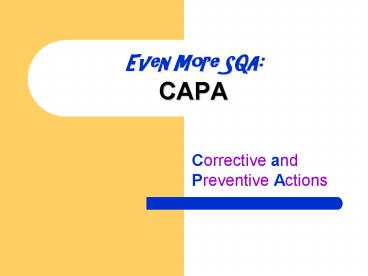Even More SQA: CAPA - PowerPoint PPT Presentation
Title:
Even More SQA: CAPA
Description:
Even More SQA: CAPA Corrective and Preventive Actions What is CAPA? activities not intended to correct defects, but to eliminate the cause of those defects. – PowerPoint PPT presentation
Number of Views:109
Avg rating:3.0/5.0
Title: Even More SQA: CAPA
1
Even More SQACAPA
- Corrective and Preventive Actions
2
What is CAPA?
- activities not intended to correct defects, but
to eliminate the cause of those defects. - corrective - fix past problems
- preventive - predict potential problems
3
Reality Check...
- How can we see into the future and fix problems
that have not yet occurred?
4
Side TopicRelated to CAPA PDCA
- PLAN
- Establish the objectives and processes necessary
to deliver results in accordance with the
specifications. - DO
- Implement the processes.
- CHECK
- Monitor and evaluate the processes and results
against objectives and specifications and report
the outcome. - ACT
- Apply actions to the outcome for necessary
improvement. This means reviewing all steps
(Plan, Do, Check, Act) and modifying the process
to improve it before its next implementation.
http//en.wikipedia.org/wiki/Plan_Do_Check_Act
5
How to conduct CAPA
- information collection
- analysis of information
- development of improved methods
- implementation of improved methods
- follow-up
6
What info gets analyzed?
- Roundup the usual suspects
- design review reports
- code walkthrough reports
- test reports
- project progress reports
- customer complaint records
- software change requests and maintenance reports
- training follow-up reports
- But don't forget
- special reports on quality / quality audits
- suggestions / observations by staff
7
Ways to sift through that huge pile of records
- asks the reporter to indicate a priority for
their report - random sampling
- combination of the two techniques above
8
When do you analyze that huge pile of records?
- Answer 1 After a plane crash.
- Answer 2 Every time a plane lands.
9
BackgroundCommon Cause and Special Cause
- " 'A riot occurs in a certain prison. Officials
and sociologists turn out a detailed report about
the prison, with a full explanation of why and
how it happened here, ignoring the fact that the
causes were common to a majority of prisons, and
that the riot could have happened anywhere.' - The quote recognizes that there is a temptation
to react to an extreme outcome and to see it as
significant, even where its causes are common to
many situations and the distinctive circumstances
surrounding its occurrence, the results of mere
chance. Such behavior has many implications
within management, often leading to interventions
in processes that merely increase the level of
variation and frequency of undesirable outcomes."
10
Control Charts
- Useful and Very Common Analysis Tool
- detect and predict problems in the process
- Lines
- Center Line mean
- Upper and Lower Control Limits (UCL and LCL)
- typically 4 standard errors
- Warning Limits
- typically 3 standard errors
- If the process is "in control", all points will
plot within the control limits.
adapted from http//en.wikipedia.org/wiki/Contro
l_chart
11
Scatter Charts (example one)
- Eruptions generally fall into two categories
- short wait, short duration
- long wait, long duration
- Hence, some simple data
- analysis yields insights
- into this process.
stolen from http//en.wikipedia.org/wiki/Scatter_d
iagram
12
Scatter Charts (example two)
- Cyclomatic Complexity v. Module Length
13
CAPA Outcome Improved Methods
- updating processes
- updating relevant work procedures
- changing tools
- improvement of reporting methods
- report contents
- report frequency
- changes in training
- probably, several of the above
14
And, of course, the obvious question
- Why bother with CAPA?































